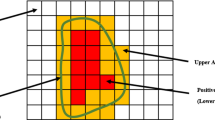Abstract
A fuzzy support vector machine (FSVM) is an improvement in SVMs for dealing with data sets with outliers. In FSVM, a key step is to compute the membership for every training sample. Existing approaches of computing the membership of a sample are motivated by the existence of outliers in data sets and do not take account of the inconsistency between conditional attributes and decision classes. However, this kind of inconsistency can affect membership for every sample and has been considered in fuzzy rough set theory. In this paper, we develop a new method to compute membership for FSVMs by using a Gaussian kernel-based fuzzy rough set. Furthermore, we employ a technique of attribute reduction using Gaussian kernel-based fuzzy rough sets to perform feature selection for FSVMs. Based on these discussions we combine the FSVMs and fuzzy rough sets methods together. The experimental results show that the proposed approaches are feasible and effective.


Similar content being viewed by others
References
Chen D, He Q, Wang X (2007) On linear separability of data sets in feature space. Neurocomputing 70(13–15):2441–2448
Dubois D, Prade H (1990) Rough fuzzy sets and fuzzy rough sets. Int J Gen Syst 17:191–209
Dubois D, Prade H (1992) Putting rough sets and fuzzy sets together. In: Slowinski R (ed) Intelligent decision support, handbook of applications and advances of the rough sets theory. Kluwer, Dordrecht
Fernandez S, Murakami S (2003) Rough set analysis of a general type of fuzzy data using transitive aggregations of fuzzy similarity relations. Fuzzy Sets Syst 139:635–660
Hassanien A (2007) Fuzzy rough sets hybrid scheme for breast cancer detection. Image Vis Comput 25(2):172–183
He Z (1983) Fuzzy mathematics and its applications. Tianjing Science Press, Tianjing
Hu Q, Yu D, Xie Z, Liu J (2006) Fuzzy probabilistic approximation spaces and their information measures. IEEE Trans Fuzzy Syst 14(2):191–201
Hu Q, Xie Z, Yu D (2007) Hybrid attribute reduction based on a novel fuzzy-rough model and information granulation. Pattern Recogn 40:3509–3521
Huang H, Liu Y (2002) Fuzzy support vector machines for pattern recognition and data mining. Int J Fuzzy Syst 4:826–835
Jensen R, Shen Q (2004) Fuzzy-rough attributes reduction with application to web categorization. Fuzzy Sets Syst 141:469–485
Lin C, Wang S (2003) Fuzzy support vector machine. IEEE Trans Neural Netw 13(2):464–471
Liu S, Du Z (2007) An improved fuzzy support vector machine method. CAAI Trans Intell Syst 2(3):30–33
Liu M, Chen D, Wu C, Li H (2006) Fuzzy reasoning based on a new fuzzy rough set and its application to scheduling problems. Comput Math Appl 51(9–10):1507–1518
Mi J, Zhang W (2004) An axiomatic characterization of a fuzzy generalization of rough sets. Inf Sci 160(1–4):235–249
Morsi N, Yakout M (1998) Axiomatics for fuzzy rough sets. Fuzzy Sets Syst 100:327–342
Moser B (2006a) On the T-transitivity of kernels. Fuzzy Sets Syst 157:1787–1796
Moser B (2006b) On representing and generating kernels by fuzzy equivalence relations. J Mach Learn Res 7:2603–2620
Pawlak Z (1982) Rough sets. Int J Comput Inf Sci 11(5):341–356
Radzikowska A, Kerre E (2002) A comparative study of fuzzy rough sets. Fuzzy Sets Syst 126:137–155
Sarkar M (2006) Ruggedness measures of medical time series using fuzzy-rough sets and fractals. Pattern Recogn Lett 27(5):447–454
Scholkopf B, Smola A (2002) Learning with kernels. The MIT Press, London
Vapnik V (1995) The nature of statistical learning theory. Springer, New York
Wang X, Yang J (2006) Richard Jensen and Xiaojun Liu, rough set feature selection and rule induction for prediction of malignancy degree in brain glioma. Comput Methods Programs Biomed 83(2):147–156
Wang Y, Wang S, Lai K (2005) A new fuzzy support vector machine to evaluate credit risk. IEEE Trans Fuzzy Syst 13:820–831
Wu W, Zhang W (2004) Constructive and axiomatic approaches of fuzzy approximation operators. Inf Sci 159(3–4):233–254
Wu W, Mi J, Zhang W (2003) Generalized fuzzy rough sets. Inf Sci 151:263–282
Yueng D, Chen D, Tsang EL et al (2005) On the generalization of fuzzy rough systems. IEEE Trans Fuzzy Syst 13:343–361
Acknowledgments
This paper is supported by NSFCs (70871036, 60773062, 60903088, 60903089), by the natural science foundation of Hebei Province (F2008000635, F2009000231, F2009000227) and by the Scientific Research Project of Department of Education of Hebei Province (2009410).
Author information
Authors and Affiliations
Corresponding author
Rights and permissions
About this article
Cite this article
He, Q., Wu, C. Membership evaluation and feature selection for fuzzy support vector machine based on fuzzy rough sets. Soft Comput 15, 1105–1114 (2011). https://doi.org/10.1007/s00500-010-0577-z
Published:
Issue Date:
DOI: https://doi.org/10.1007/s00500-010-0577-z




